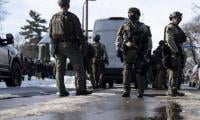We need closure
During the peak of the operations in several Fata agencies including Bajaur, Mohmand, South Waziristan and the bordering settled areas that I covered extensively, one of my running arguments with senior military commanders centred on ‘closure.’ In any number of briefings and field-reporting chats, the answers, even though reassuring, never came up to my journalistic expectation.
These answers focused on highlighting the significance of breakthroughs such as smashing hardened networks, killing their command and control structures and recapturing territory that was lost to them over the past many years. However, they always fell short of the kind of clear-cut statement that I was looking for – that is: ‘when (and whether) the residents of Fata would see normal life again’.
General Tariq Khan, then IG FC KP, a superb commander, and at present in the news for all the wrong reasons, was particularly vocal in narrowing down the gains to clearing the territory of all mal-content and bringing the affairs of these agencies under the state’s heel. He waved off queries about the terrorists’ commanders, such as Fazlullah, who he believed were on the run and therefore had become too insignificant to be bothered about.
Over the years these qualified answers to black-and-white queries have been proven to be correct. We understand better now that the nature of terrorism has become so dynamic and its shape so prone to mutation that all achievements will remain relative. We have learnt to our sorrow that success will be incremental, never total. We know that the cost of holding on to our gains will have to be paid repeatedly.
Yet issues that grow out of absence of total closure too have been proven be just as relevant. We know for instance how much damage Fazlullah has done to Pakistan. We are well aware how other commanders left out of the mopping up phase, say in Khyber Agency, have over the years cost the nation dearly in sweat and precious blood.
In every venture that involves human and material sacrifice and which impacts the long-term stability of the nation, the final chapter cannot be kept open forever. There has to be closure. While the war against terrorists is an exception, even the most complex military operations have to come to an end after meeting their central goals. In other areas where the goals are less clearly articulated but tackling them is both time and resource-consuming, the urgency of driving the final nail and setting the final stone is even more pressing.
Leave aside the Panama pressure and there is reason to believe that Prime Minister Nawaz Sharif has ample time and space available to him to pay attention to issues that require closure. With COAS General Qamar Bajwa well-ensconced at GHQ, assisted by a team of his choice, the prime minister’s attention can be both productive and purposeful.
Atop the list of closure-issues sit Karachi and MQM politics. Where do the federal government and the establishment (they are still two different ‘objects’ with their own orbits) want to see the city go? Is Altaf Hussain’s MQM a terrorist organisation and are Farooq Sattar and Co only a front for it? If so, kick them out of politics, prove their crimes and be done with it. To keep the issue of the legitimacy of the MQM (both factions) hanging is to let the city remain on the edge. To let the past continue to hobble the present is making the future bleak and cloudy.
The ‘pressure and crumble’ strategy of the Raheel-Rizwan years got exhausted pretty quickly as the Pak Sarzameen Party, instead of growing wings, became a clinger needing constant feeding. But because admitting reality was not the strongest virtue of the last command, everybody kept on pretending that the political situation was shaping up nicely. Now it is a mess you cannot make head or tail of. There was a time when Karachi needed cleansing. Now it needs closure. The end-state, whatever it is, must be expedited and enforced.
Next is Balochistan, where a state of gnawing political illness pervades every facet of provincial life. The province is rudderless because it is leaderless. And it is leaderless because both Pindi and Islamabad have tried to run it from afar, using strategic maps and big theories of its pivotal role in regional and global politics. The much-talked about dialogue with the ‘dissident Balochs’ is dead. The healing touch of democratic government has foundered on the rock of Indian support to the so-called separatists. The dysfunctional provincial government is a farcical front of an establishment whose members sound Einsteinian in their discourse about the province but are clueless when it comes to finding nuanced and workable solutions to its seedy politics. For the federal government Balochistan is a backwater island useful only with reference to the CPEC.
This is an atrocious situation. An Afghanistan-bordering, politically injured province with long-running grievances and an expanding threat of sectarian war cannot be cast to the wind of neglect. What is our national plan to expedite Balochistan’s development, create local avenues of economic opportunity, curb the expanding influence of non-state actors and, what’s more, energise and revive healthy politics?
Where do we see Balochistan, say, ten years from now? How does its political dynamics play out when the Baloch become a marginalised and impoverished minority in their own province (partly also because of its sardars now sitting abroad) and the demography shifts decisively in favour of other groups? How would its archaic political structure fare in the face of monumental changes? What about Baloch youth? What is our plan for them? These questions need answers and a start has to be made by closing the files, one way or the other, on sectarian and separatists groups. If hard-end solutions cannot be found, then form a truth and reconciliation commission and move on with life. Don’t let it asphyxiate like fish on the hook.
Similar is the urgency of taking the final decision on Fata. The last three years have seen admirable work. The Fata Reforms Report, with all its flaws and weaknesses, is a mighty useful way forward. A few months ago it looked as if the impossible might happen and the Sharif government could begin the phase of its implementation. Then the process got stalled because Maulana Fazlur Rehman threw a spanner in the works and the Sharif government succumbed to his pressure. Now the momentum has to be reignited.
Fata’s fate cannot be left to the vagaries of silly political circumstances and petty personal interests. If it is Fata’s merger with Khyber Pakhtunkhwa, let it start in all earnest and this chapter must be brought to an end.
And, parallel to this decision, there must be stock taking and closure in Fata at another level: the people have to be resettled in their homes and their lives given a decent base for a restart. While the nation has been made to bow to the lords of Operation Zarb-e-Azb, its impact on the ground has been allowed to slip out of national sight. North Waziristan needs a major reconstruction effort. Excessive use of expensive precision-guided ammunition has played havoc. People are displaced and statistics about the high percentage of IDPs returning home are unverified. In other agencies like parts of Khyber and now Orakzai and the outer fringes of Bajaur, loose ends need to be tied up to create a meaningful and practical narrative of success.
There are other areas too where the word ‘closure’ needs to be made the keystone of tough decisions but for now the ones mentioned above suffice. Imagine a stable and politically sane Karachi, a politically revved up Balochistan and a Fata where slogans have been replaced by real work on people’s lives. Imagine these three and then imagine Pakistan. That’s what closure can bring to a country whose various parts at present are akin to festering and bleeding wounds.
The writer is former executive editor of The News and a senior journalist with Geo TV.
Email: syedtalathussain@gmail.com
Twitter: @TalatHussain12
-
 Minneapolis: ICE Officer Fires Bullet After Migrant Attacks With A Shovel
Minneapolis: ICE Officer Fires Bullet After Migrant Attacks With A Shovel -
 Prince William Gets 'mobbed' By Animals During Rural Engagement
Prince William Gets 'mobbed' By Animals During Rural Engagement -
 Angelina Jolie Finally Escaping L.A.?
Angelina Jolie Finally Escaping L.A.? -
 Jodie Foster Reflects On Harsh Reality Of Why She Escaped Sexual Abuse As Actress
Jodie Foster Reflects On Harsh Reality Of Why She Escaped Sexual Abuse As Actress -
 Matthew McConaughey Takes Legal Action To Save THIS Iconic Phrase From AI Misuse
Matthew McConaughey Takes Legal Action To Save THIS Iconic Phrase From AI Misuse -
 Prince Harry, Meghan Markle To Have Baby In 2026?
Prince Harry, Meghan Markle To Have Baby In 2026? -
 Bella Hadid Steals The Spotlight At 'The Beauty' Premiere
Bella Hadid Steals The Spotlight At 'The Beauty' Premiere -
 Taylor Swift 'worst Photos': Singer's Not-so-perfect Moments Spark Debate
Taylor Swift 'worst Photos': Singer's Not-so-perfect Moments Spark Debate -
 Arizona Mother Traces Missing Son Living In Neighbour’s Home After Killing Hm
Arizona Mother Traces Missing Son Living In Neighbour’s Home After Killing Hm -
 OpenAI Launches ChatGPT Translate To Rival Google Translate
OpenAI Launches ChatGPT Translate To Rival Google Translate -
 Top AI Themes Poised To Shape 2026: Here’s How
Top AI Themes Poised To Shape 2026: Here’s How -
 Meghan Markle Accused Of Stealing 'bookmark' Idea
Meghan Markle Accused Of Stealing 'bookmark' Idea -
 Leonardo DiCaprio Changes His Stance On THIS To Remain 'his Handsome Self'
Leonardo DiCaprio Changes His Stance On THIS To Remain 'his Handsome Self' -
 Girl Dies After Years Of Alleged Starvation By Mother In West Virginia
Girl Dies After Years Of Alleged Starvation By Mother In West Virginia -
 Here’s How Many Under-16 Social Media Accounts Were Removed In Australia
Here’s How Many Under-16 Social Media Accounts Were Removed In Australia -
 Drew Barrymore Gets Candid About The Words That Haunted Her Childhood
Drew Barrymore Gets Candid About The Words That Haunted Her Childhood



